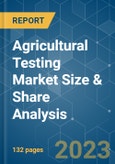The Agricultural Testing Market size is expected to grow from USD 5.71 billion in 2023 to USD 7.53 billion by 2028, at a CAGR of 5.70% during the forecast period (2023-2028).
Key Highlights
- Agricultural testing can be defined as the testing of various samples, such as water, soil, seed, etc., to determine their quality and contaminant content. The agricultural testing market is a high-growth sector and is gaining popularity in developed and commercialized regions across the globe. Regulations and legalizations pertaining to environmental safety and agricultural productivity have been the major driving force for the market growth of agricultural testing.
- Over the medium term, the market is anticipated to witness robust recovery with higher demand for agricultural products, resulting in increased production and a need for periodic soil testing. Similarly, the shift in consumer preference to a higher standard of food safety and quality in terms of chemical residues creates the need to maintain the soil properties for quality production, thereby bolstering the market growth during the forecast period.
- North America dominates the agricultural testing market. The dominant share of the region is attributed to the stringency in food safety, environmental and agricultural regulations, and laws pertaining to nutritional content, chemicals, and labeling. The presence of numerous agriculture testing service providers in the region contributes to the growth of the agriculture testing service market.
Agricultural Testing Market Trends
Regulations and Legislations Pertaining to Agriculture and Environmental Safety
- Regulations and legalizations about environmental safety and agricultural productivity have been the major driving factor for the market growth. With the rising concerns, governments are acting proactively in the direction of agriculture and food safety, driving the market growth. For instance, the Food and Drug Administration (FDA) recently proposed revising Subpart E of the FDA Food Safety Modernization Act (FSMA) Produce Safety Rule. The proposed changes aim to enhance food safety by ensuring that the water used for irrigation and other agricultural purposes does not contain harmful contaminants that can lead to foodborne illness.
- Under the proposed requirements, covered farms would be required to conduct pre-harvest agricultural water assessments at least once annually and whenever a change occurs, increasing the likelihood of contamination. This change in the regulation aims to provide greater flexibility to farmers and reduce the burden of compliance with the regulation while also ensuring that the product is safe for consumers.
- Sample testing has become increasingly popular in commercialized agriculture countries to maintain the export growth of agricultural commodities.
- Seed and Soil testing has also gained popularity in recent times. International Seed Testing Association (ISTA) is an international organization that aims to develop and publish standard procedures in seed testing. It has gained recognization in many countries as an important tool to harmonize seed testing and modern trends in the seed trade. Therefore, the growing need to address various issues and challenges across the agricultural supply chain and food safety has increased market potential for agricultural testing products.
North America Dominates the Market
- North America is the largest market for agricultural testing across the globe. The United States, among all the regional countries, provides an attractive market potential for the players. There is an ongoing demand for seed testing in the country due to the requirements of certifications for United States seeds and grains.
- The Seed Regulatory and Testing Division (SRTD) tests agricultural and vegetable seeds to ensure the efficient, orderly marketing of seeds and to assist in developing new or expanding markets. These are aiding the growth of the market. In the region, there is an increase in the trend of following electrophoretic and serological methods in seed testing.
- The electrophoretic method is used for the assessment of seed storage proteins. Furthermore, the electrophoretic method may be used to identify and test the cultivar purity of seeds. In contrast, serological methods are suitable for species identification of seeds and determination of species composition of admixtures. In addition, the serological method allows the display of the species specificity of seed proteins. The shift in consumer preference toward a higher standard of food safety and quality, in terms of chemical residues, creates the need to maintain the soil properties for quality production, thereby bolstering the market growth during the forecast period.
Agricultural Testing Industry Overview
The global agricultural testing market is moderately consolidated, with numerous government-operated laboratories providing various agricultural testing services to farmers worldwide. Eurofins Scientific, R J Hill Laboratories LTD, Agilent Technologies, Inc, SCS Global Services, and Charm Sciences Inc. are some of the major players. Companies compete in the agricultural testing market based on equipment quality and promotion and focus on strategic moves to hold larger market shares. New services, partnerships, and acquisitions are the major strategies adopted by the leading companies in the market globally.Additional Benefits:
- The market estimate (ME) sheet in Excel format
- 3 months of analyst support
Table of Contents
1 INTRODUCTION
4 MARKET DYNAMICS
5 MARKET SEGMENTATION
6 COMPETITIVE LANDSCAPE
Companies Mentioned (Partial List)
A selection of companies mentioned in this report includes, but is not limited to:
- Eurofins Scientific
- Agilent Technologies Inc.
- SCS Global Services
- Bureau Veritas SA
- ALS Limited
- Element Materials Technology
- TUV Nord Group
- Apal Agricultural Laboratory
- Intertek Group PLC
- EMD Millipore Corporation
- BioMerieux SA
- Aurea Agrosciences
- 3M Company
- Charm Sciences Inc.
- Neogen Corporation
- Biolumix Inc.
Methodology

LOADING...










